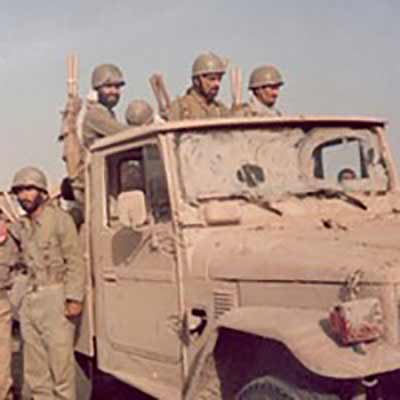Battles
Operation Nasr 6
Azam Sadat Hussaini
168 دورہ
Operation Nasr 6
Written by: Azam Sadat Hussaini
In August 1987, The Islamic Republic of Iran Army Ground Forces launched Operation Nasr 6 to liberate parts of the Halaleh that had been occupied by the Iraqi army.
The Meimak Heights, located along the border of Ilam Province, were claimed by Iraq as part of its territory. On September 9, 1980—thirteen days before the outbreak of the Iran-Iraq War—Iraq occupied Meimak. However, within two days, the Iraqi offensive was met with strong resistance from Iranian forces.
On July 25, 1987, the Iraqi army—deploying thirteen brigades, including infantry commandos and artillery—attacked the western and northwestern sides of the Meimak Heights, successfully reoccupying those areas.
In response, on August 1st, the Iranian Army carried out Operation Nasr 6 with code-name “Ya Aba Abdillah al-Hussain (as)” to retake parts of the Halaleh (Salehabad–Meimak Heights). The operation lasted thirteen days.[1]
During this operation, Iranian forces managed to break through the enemy’s defensive lines and positions significantly damaging Iraq’s 4th Army Corps and forcing the enemy to leave the area. Consequently, some parts of the surrounding areas of Meimak Heights were recaptured, and Iranian troops were positioned on the peaks.[2] Likewise, after successfully destroying the remaining units of Iraq’s 2nd Army Corps positioned in northern Meimak Heights, the Iranian Army forces fully captured Height 670 and the strategic Shuhada Hill.[3] Also, backed by the Iranian Army Air Force and artillery fire, the units inflicted heavy losses on Iraqi troops.[4]
Operation Nasr 6 was among the most intense battles fought in the Meimak Heights during the entire war. By deploying 30 helicopters and flying a total of 350 hours, the Islamic Republic of Iran Army Aviation (Havanirooz) pilots evacuated 375 wounded soldiers, airlifted 446 combatants, and delivered 2.5 tons of ammunition and supplies to the front lines.[5]
The Iraqi units that were destroyed or severely damaged in operation included the 36th Infantry Brigade of the 2nd Division (60–70%), the 4th Infantry Brigade (100%), the 108th Infantry Brigade of the 16th Division (80%), the 1st Commando Brigade of the 1st Army Corps (50%), a commando battalion of the 4th Army Corps (100%) with the remaining battalions (60%), the 801st Brigade (65%), the 95th Brigade of the 23rd Division (45%), the 705th Brigade of the 28th Division (80%), the 70th Armored Brigade of the 17th Division, the 77th Infantry Brigade of the 1st and 65th divisions, the Special Forces Division, the 10th Armored Brigade, the Hattin Commando Battalion, the 17th Mechanized Battalion of the 59th Brigade of the 17th Division (50–55%), the 241st, 16th, 81st, 30th, and 1st Artillery battalions (35–50%), and the 240th, 3rd, 4th, 5th, 6th, 7th, 8th, 9th, 10th, 11th, 12th, 247th, 661st, and 928th battalions (25–40%).[6]
In total, 2 Iraqi aircraft, 17 tanks and armored personnel carriers, several artillery pieces, 6 helicopters, and hundreds of vehicles were destroyed. Iraqi casualties in this operation numbered around 2500 killed or wounded, and 120 were taken prisoner—including 11 officers and 30 non-commissioned ones.[7]
According to a report from the Iranian Army Intelligence Division, despite Iraqis’ concentrated efforts in the Meimak, they were ultimately forced into taking a defensive posture. Even though all the local and international media covered the news on the outcomes of this operation, none of Iraq’s official military communiqués made any reference to the engagement of the Iraq 2nd Army Corps in the battle.[8]
[1] Razaqzadeh, Amir. Atlas-e Rahnama 3: Ilam dar Jang (Guiding Atlas 3: Ilam in War), Tehran: Markaz-e Motaleat va Tahqiqat-e Jang-e Sepah-e Pasdaran-e Enqelab-e Eslami, 2nd edition, 2004, Pp. 52 and 54; Jafari, Mojtaba. Atlas-e Nabardha-ye Mandegar (Atlas of Enduring Battles), Tehran: Soore-ye Sabz, 35th edition, 2014, p. 142.
[2] Razaqzadeh, Amir. Atlas-e Rahnama 3 (Guiding Atlas 3), p. 52.
[3] Yazdanfam, Mahmoud. Rouzshomare Jang-e Iran va Araq, Ketab-e Panjahom: Escort-e Naftkashha (Chronology of the Iran-Iraq War, Volume 50: Escorting Oil Tankers), Tehran: Markaz-e Motaleat va Tahqiqat-e Jang-e Sepah-e Pasdaran-e Enqelab-e Eslami, 1999, p. 161.
[4] Ibid.
[5] Jafari, Mojtaba. Atlas-e Nabardha-ye Mandegar (Atlas of Enduring Battles), Tehran: Soore-ye Sabz, 35th edition, 2014, p. 142.
[6] Jomhouri-ye Eslami Newspaper (Jomhouri-ye Eslami Newspaper), No. 2371, August 3, 1987, p. 2.
[7] Samiei, Ali. Karnam-e Tawsifi-ye Amaliyat-e Razmandegan-e Eslam dar Tool-e Hasht Saal-e Defa-e Muqaddas (Descriptive Report of the Operations of Islamic Combatants during the Eight Years of Sacred Defense), Tehran: Namayandegi-ye Vali-e Faqih dar Niroo-ye Zamini, Moavenat-e Tablighat va Entesharat, Modiriyat-e Nashr, 1997, p. 350; Yazdanfam, Mahmoud. Rouzshomare Jang-e Iran va Araq, Ketab-e Panjahom (Chronology of the Iran-Iraq War, Volume 50), p. 161.
[8] Yazdanfam, Mahmoud. Rouzshomare Jang-e Iran va Araq, Ketab-e Panjahom (Chronology of the Iran-Iraq War, Volume 50), p. 162.



